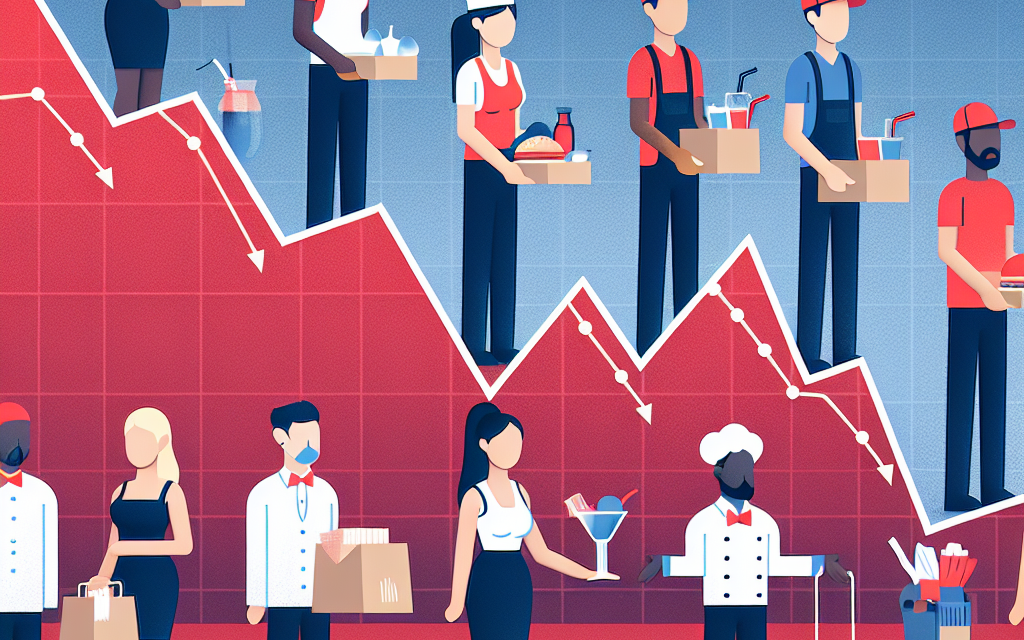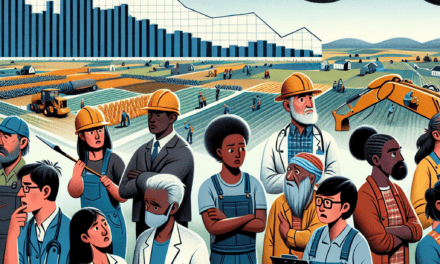“Rethinking Generosity: The Shift in America’s Tipping Culture.”
Introduction
In recent years, the practice of tipping in the United States has experienced a notable decline, reflecting shifting social norms and economic factors. Traditionally viewed as a customary gesture of appreciation for service, tipping is now being reevaluated by many Americans. Factors contributing to this trend include changing attitudes towards service industry wages, the rise of automated payment systems, and a growing awareness of income inequality. As consumers navigate these evolving dynamics, the implications for service workers and the broader economy are significant, prompting discussions about fair compensation and the future of tipping culture in America.
Changing Attitudes Toward Tipping
In recent years, the landscape of tipping in the United States has undergone a significant transformation, reflecting broader societal changes and evolving attitudes toward service and compensation. Traditionally, tipping has been viewed as a customary practice, a way for patrons to express gratitude for good service. However, a growing number of Americans are beginning to question the necessity and fairness of this practice, leading to a decline in tipping trends across various sectors.
One of the primary factors contributing to this shift is the increasing awareness of wage disparities within the service industry. Many service workers, particularly in restaurants and hospitality, rely heavily on tips to supplement their base wages, which are often set below the federal minimum wage. This reliance on tips has sparked discussions about the ethics of such a system, prompting some consumers to reconsider their role in perpetuating a model that may not adequately support workers. As a result, many individuals are advocating for a more equitable wage structure that does not place the burden of compensation solely on the customer.
Moreover, the rise of technology and digital payment systems has also influenced tipping behavior. With the advent of mobile payment apps and point-of-sale systems that prompt customers to tip, many consumers feel pressured to leave gratuities even when they may not feel inclined to do so. This pressure can lead to a sense of obligation rather than genuine appreciation, which diminishes the significance of the tip itself. Consequently, some patrons are opting to forgo tipping altogether, viewing it as an insincere gesture rather than a meaningful expression of gratitude.
Additionally, the COVID-19 pandemic has played a pivotal role in reshaping attitudes toward tipping. As the pandemic forced many businesses to adapt to new operational models, including takeout and delivery services, consumers began to reassess their expectations regarding service. The emphasis on contactless transactions and the rise of gig economy workers have further complicated the traditional tipping landscape. Many individuals have expressed confusion about when and how much to tip in these new contexts, leading to inconsistent practices and a decline in overall tipping rates.
Furthermore, cultural shifts regarding consumerism and social responsibility have also impacted tipping trends. A growing number of Americans are prioritizing ethical consumption, seeking to support businesses that align with their values. This shift has led some consumers to favor establishments that offer fair wages and benefits to their employees, rather than relying on tips as a primary source of income. As awareness of social justice issues continues to rise, many patrons are choosing to direct their financial support toward businesses that demonstrate a commitment to equitable labor practices.
In conclusion, the decline in tipping trends among Americans can be attributed to a confluence of factors, including changing perceptions of wage equity, the influence of technology, the impact of the pandemic, and evolving cultural values. As society grapples with these complex issues, it is likely that the practice of tipping will continue to evolve, reflecting a broader reexamination of how we value and compensate service work. Ultimately, this shift may pave the way for a more equitable and sustainable approach to labor compensation, fostering a service industry that prioritizes fair wages and respectful treatment for all workers.
Impact of the Gig Economy on Tipping Practices
The rise of the gig economy has significantly transformed various aspects of American life, including tipping practices. As more individuals engage in freelance work or part-time jobs through platforms such as Uber, Lyft, DoorDash, and TaskRabbit, the traditional norms surrounding gratuity are evolving. This shift is not merely a reflection of changing consumer behavior but also highlights the complexities of the modern labor market, where workers often rely on tips as a crucial component of their income.
One of the most notable impacts of the gig economy on tipping practices is the increased visibility of service workers. Gig platforms have democratized access to services, allowing consumers to connect with workers directly. However, this direct interaction often leads to confusion regarding the appropriate tipping etiquette. For instance, while a diner may feel compelled to tip a waiter at a restaurant, the same diner might hesitate when ordering food through a delivery app, questioning whether the service warrants a similar gratuity. This inconsistency can result in lower overall tips for gig workers, who may already be earning less than their traditionally employed counterparts.
Moreover, the gig economy has introduced a new layer of complexity to the relationship between service providers and consumers. Many gig workers operate under the assumption that their earnings will be supplemented by tips, yet the nature of their work can lead to varying expectations. For example, a rideshare driver may provide an exceptional experience, yet the passenger might not feel obligated to tip, especially if the fare is perceived as already high. This perception can be exacerbated by the fact that many gig platforms have implemented service fees, which can create a false sense of security for consumers, leading them to believe that they are already compensating the worker adequately.
Additionally, the gig economy has fostered a culture of convenience that often undermines the traditional tipping model. With the advent of technology, consumers can now access services with just a few taps on their smartphones. This convenience can diminish the personal connection that typically influences tipping behavior. When a consumer orders a ride or food delivery, the interaction is often brief and transactional, which may lead to a reduced sense of obligation to tip. As a result, many gig workers find themselves navigating a landscape where their efforts are less recognized, and their income becomes increasingly unpredictable.
Furthermore, the gig economy has also contributed to a broader societal shift in attitudes toward tipping. As more people engage with gig services, there is a growing debate about the fairness of relying on tips to supplement wages. Critics argue that this practice perpetuates income instability and places an undue burden on consumers to compensate for inadequate base pay. Consequently, some consumers may choose to tip less or not at all, believing that it is the responsibility of the employer to provide a living wage rather than relying on gratuities.
In conclusion, the impact of the gig economy on tipping practices among Americans is multifaceted and reflects broader changes in the labor market and consumer behavior. As gig work continues to grow, it is essential to recognize the implications for service workers who depend on tips for their livelihood. Understanding these dynamics can foster a more equitable approach to tipping, ensuring that workers receive fair compensation for their services while navigating the complexities of modern consumer expectations.
The Role of Technology in Tipping Decline
In recent years, the landscape of tipping in the United States has undergone significant changes, with a noticeable decline in the frequency and amount of tips given by consumers. One of the most influential factors contributing to this trend is the rapid advancement of technology, which has transformed not only how services are delivered but also how consumers interact with service providers. As digital payment systems and mobile applications become increasingly prevalent, they have altered the traditional dynamics of tipping, leading to a reevaluation of its necessity and appropriateness.
To begin with, the rise of cashless transactions has played a pivotal role in diminishing the practice of tipping. With the convenience of credit and debit cards, as well as mobile payment platforms like Venmo and Cash App, many consumers no longer carry cash. This shift has made it more challenging for individuals to tip service workers, particularly in industries where cash tips were once the norm, such as restaurants and personal services. As a result, the absence of physical currency has created a barrier to tipping, leading to a decline in the overall amount given.
Moreover, the integration of technology into service industries has introduced new payment models that often include service charges or automatic gratuities. For instance, many restaurants now add a service charge to the bill, particularly for larger parties, which can lead customers to feel that an additional tip is unnecessary. This practice not only reduces the incentive for patrons to tip but also raises questions about the fairness of compensating service workers through mandatory fees rather than voluntary gratuities. Consequently, consumers may perceive tipping as less essential, further contributing to the decline in tipping trends.
In addition to these changes, the emergence of delivery apps and gig economy platforms has transformed the way services are rendered and compensated. Services such as Uber, DoorDash, and Postmates have created a new paradigm where tipping is often presented as an optional add-on rather than a customary practice. While these platforms encourage tipping, the ease of opting out or selecting a lower tip amount has led many consumers to do just that. This shift in consumer behavior reflects a broader trend of detachment from traditional tipping norms, as individuals navigate a digital landscape that prioritizes convenience over customary practices.
Furthermore, the growing awareness of wage disparities and the push for fair compensation for service workers have also influenced tipping behavior. As discussions around living wages and equitable pay gain traction, some consumers may feel conflicted about tipping, questioning whether it is an appropriate way to support workers who should be receiving fair wages from their employers. This evolving perspective on compensation has led to a decline in the perceived necessity of tipping, as individuals grapple with the implications of their financial choices.
In conclusion, the decline in tipping trends among Americans can be largely attributed to the role of technology in reshaping consumer behavior and service delivery. The transition to cashless transactions, the introduction of service charges, the rise of gig economy platforms, and the growing discourse on fair wages have all contributed to a reevaluation of tipping practices. As society continues to adapt to these technological advancements, it remains to be seen how tipping will evolve in the future and whether it will regain its status as a customary expression of gratitude or continue to diminish in significance.
Cultural Shifts in Service Expectations
In recent years, the landscape of tipping in the United States has undergone significant changes, reflecting broader cultural shifts in service expectations. Traditionally, tipping has been viewed as a customary practice, a way for patrons to express gratitude for good service. However, as societal norms evolve, so too do the expectations surrounding this practice. One of the most notable shifts is the growing sentiment that tipping should not be a necessary component of service, but rather an optional gesture based on the quality of the experience.
This transformation can be attributed to several factors, including the increasing prevalence of service charges and the rising minimum wage in various states. Many establishments have begun to implement automatic service charges, particularly in fine dining and large group settings. This practice not only simplifies the payment process for customers but also raises questions about the role of tipping in compensating service workers. As a result, patrons may feel less inclined to leave additional gratuities when they perceive that a fair wage is already being provided through these service charges.
Moreover, the pandemic has accelerated changes in consumer behavior and attitudes toward tipping. During the COVID-19 crisis, many service workers faced unprecedented challenges, leading to a surge in public support for fair wages and better working conditions. This shift in perspective has prompted some consumers to reconsider their tipping habits, with many opting to support businesses that prioritize employee welfare over traditional tipping practices. Consequently, the notion that tipping is an obligatory act has begun to wane, as more individuals advocate for a system that ensures workers receive a living wage without relying on gratuities.
In addition to these economic factors, cultural influences play a significant role in shaping attitudes toward tipping. The rise of technology and digital payment systems has transformed the way consumers interact with service providers. With the advent of apps and platforms that facilitate cashless transactions, the act of tipping has become more transactional and less personal. This shift has led to a detachment from the emotional connection that often accompanies tipping, as patrons may feel less inclined to leave a gratuity when the interaction is mediated by technology.
Furthermore, generational differences in attitudes toward tipping cannot be overlooked. Younger consumers, particularly millennials and Generation Z, tend to prioritize experiences over material possessions and are more likely to support businesses that align with their values. This demographic is increasingly vocal about their expectations for fair wages and ethical business practices, which may contribute to a decline in traditional tipping behaviors. As these younger generations enter the workforce and become the primary consumers, their preferences are likely to shape the future of tipping in America.
In conclusion, the decline in tipping trends among Americans can be attributed to a confluence of cultural shifts in service expectations, economic changes, and evolving consumer behaviors. As society moves toward a more equitable approach to compensation for service workers, the traditional practice of tipping is being redefined. This evolution reflects a broader desire for fairness and transparency in the service industry, suggesting that the future of tipping may look markedly different from its past. As these trends continue to unfold, it will be essential for both consumers and service providers to navigate this changing landscape with an understanding of the underlying values that drive these shifts.
Economic Factors Influencing Tipping Behavior
The decline in tipping trends among Americans can be attributed to a variety of economic factors that have significantly influenced consumer behavior in recent years. As the economy fluctuates, so too do the financial priorities of individuals, leading to a reevaluation of customary practices such as tipping. One of the most prominent factors is the rising cost of living, which has placed considerable strain on household budgets. As expenses for essentials like housing, food, and healthcare continue to escalate, many consumers find themselves with less disposable income to allocate toward gratuities. This shift in financial capability has prompted a more cautious approach to tipping, as individuals prioritize their own financial stability over traditional social norms.
Moreover, the economic impact of the COVID-19 pandemic has further exacerbated this trend. The pandemic not only disrupted employment for millions but also altered consumer spending habits. With many Americans facing job insecurity or reduced hours, the inclination to tip generously has diminished. In addition, the rise of remote work has led to a decrease in dining out and other service-related activities, which are typically associated with tipping. As people have adapted to a more home-centered lifestyle, the opportunities for tipping have naturally declined, resulting in a noticeable shift in behavior.
In conjunction with these economic pressures, the growing awareness of wage disparities within the service industry has also influenced tipping practices. Many consumers are becoming increasingly cognizant of the fact that service workers often rely on tips to supplement their income, yet this awareness does not always translate into increased gratuities. Instead, some individuals argue that service workers should receive a living wage from their employers, thereby reducing the necessity for tipping altogether. This perspective has gained traction, particularly among younger generations who are more inclined to advocate for systemic changes in labor practices. As a result, the traditional expectation of tipping may be viewed as an outdated practice that fails to address the root causes of income inequality.
Additionally, the proliferation of technology in the service industry has introduced new dynamics to the tipping landscape. With the advent of mobile payment systems and digital platforms, consumers are often prompted to tip at the point of sale, which can create a sense of obligation. However, this convenience can also lead to confusion regarding appropriate tipping amounts, resulting in inconsistent practices. As consumers navigate these new systems, they may feel less inclined to tip generously, particularly if they perceive the service as subpar or if they are unsure of the customary rates.
Furthermore, the cultural shift towards minimalism and financial prudence has led many Americans to reassess their spending habits, including tipping. As individuals prioritize experiences over material possessions, they may choose to allocate their financial resources differently, often resulting in reduced gratuities. This change in mindset reflects a broader societal trend towards valuing financial responsibility and sustainability, which can further diminish the inclination to tip.
In conclusion, the decline in tipping trends among Americans is a multifaceted issue influenced by economic factors such as rising living costs, the impact of the pandemic, wage disparities, technological advancements, and changing cultural values. As these elements continue to shape consumer behavior, it remains to be seen how tipping practices will evolve in the future, potentially leading to a redefinition of social norms surrounding gratuities in the service industry.
Generational Differences in Tipping Habits
In recent years, the landscape of tipping in the United States has undergone significant changes, particularly when examining the generational differences that influence these habits. As societal norms evolve, so too do the expectations surrounding gratuity, leading to a noticeable decline in tipping trends among Americans. This shift can be attributed to various factors, including changing attitudes toward service, economic considerations, and the impact of technology on consumer behavior.
Younger generations, particularly Millennials and Generation Z, exhibit markedly different attitudes toward tipping compared to their older counterparts, such as Baby Boomers and Generation X. For instance, while older generations often view tipping as a customary practice rooted in tradition, younger individuals are more likely to question the necessity and fairness of tipping in the service industry. This skepticism is often fueled by a growing awareness of wage disparities and the belief that employers should provide fair compensation to their employees without relying on tips as a significant portion of their income. Consequently, younger consumers may choose to tip less or not at all, particularly in situations where they perceive the service to be subpar or where they feel that the establishment should be responsible for adequately compensating its staff.
Moreover, the economic landscape plays a crucial role in shaping tipping behaviors across generations. Younger Americans are increasingly burdened by student debt, rising living costs, and stagnant wages, which can lead to a more cautious approach to discretionary spending, including tipping. In contrast, older generations, who may have experienced more stable economic conditions during their formative years, often maintain a more generous tipping culture. This divergence in financial circumstances not only influences how much individuals are willing to tip but also reflects broader societal shifts in attitudes toward money and spending.
Additionally, the rise of technology and digital payment systems has transformed the way consumers engage with tipping. Mobile payment platforms and apps have made it easier than ever to leave a gratuity, yet they have also introduced a level of detachment from the act of tipping itself. Younger generations, who are more accustomed to using these technologies, may find themselves tipping less frequently or opting for lower amounts, as the convenience of digital transactions can diminish the personal connection often associated with cash tips. Furthermore, the prevalence of suggested tip percentages on screens can lead to confusion or frustration, prompting some consumers to simply bypass the tipping process altogether.
As these generational differences continue to shape the tipping landscape, it is essential to consider the implications for service workers and the broader economy. The decline in tipping among younger Americans may lead to increased calls for reform in wage structures within the service industry, as workers advocate for more equitable compensation models that do not rely heavily on gratuities. This shift could ultimately foster a more sustainable and fair working environment for service employees, while also prompting businesses to reevaluate their pricing strategies and service models.
In conclusion, the decline in tipping trends among Americans can be largely attributed to generational differences in attitudes, economic realities, and the influence of technology. As younger generations challenge traditional norms and advocate for fair compensation practices, the future of tipping in the United States remains uncertain. Understanding these dynamics is crucial for both consumers and service providers as they navigate this evolving landscape.
The Future of Tipping: Predictions and Trends
As the landscape of dining and service industries continues to evolve, the future of tipping in America appears to be shifting in significant ways. Recent trends indicate a decline in traditional tipping practices, prompting discussions about the implications for service workers and the broader economy. This decline can be attributed to several factors, including changing consumer attitudes, the rise of technology, and the ongoing impact of the COVID-19 pandemic. Understanding these dynamics is crucial for predicting how tipping practices may evolve in the coming years.
One of the most notable changes in consumer attitudes towards tipping is the growing awareness of wage disparities within the service industry. Many Americans are increasingly recognizing that tipping can perpetuate inequities, particularly for workers in lower-paying jobs. As a result, there is a rising sentiment that service workers should receive fair wages without relying on tips as a significant portion of their income. This shift in perspective may lead to a more widespread adoption of no-tipping policies, as some establishments experiment with inclusive pricing models that incorporate service charges into menu prices. Such changes could fundamentally alter the relationship between customers and service workers, fostering a more equitable environment.
Moreover, the integration of technology into the dining experience has also played a pivotal role in reshaping tipping trends. With the advent of mobile payment systems and digital ordering platforms, consumers are increasingly presented with options that may not include a traditional tipping mechanism. For instance, many fast-casual restaurants and delivery services have adopted a model where service charges are automatically included in the total bill, thereby reducing the emphasis on tipping as a discretionary act. This technological shift not only streamlines the payment process but also raises questions about the future relevance of tipping in a world where convenience and efficiency are prioritized.
Additionally, the COVID-19 pandemic has had a profound impact on tipping behaviors. During the height of the pandemic, many consumers felt compelled to support service workers who were facing unprecedented challenges. This led to a temporary increase in tipping as patrons sought to express gratitude for the services provided during difficult times. However, as the pandemic has waned and economic pressures have mounted, some consumers are reevaluating their tipping habits. Rising inflation and increased living costs may lead to a more cautious approach to discretionary spending, including tips. Consequently, this could result in a further decline in tipping as consumers prioritize their financial stability over traditional practices.
Looking ahead, it is essential to consider how these trends may influence the future of tipping in America. While some establishments may continue to embrace tipping as a means of incentivizing service quality, others may adopt alternative compensation models that prioritize fair wages over gratuities. As consumer preferences evolve, businesses will need to adapt to meet the changing expectations of their patrons. This may involve rethinking pricing strategies, enhancing transparency around service charges, and fostering a culture that values equitable compensation for all workers.
In conclusion, the future of tipping in America is likely to be shaped by a confluence of factors, including changing consumer attitudes, technological advancements, and the lasting effects of the pandemic. As society grapples with these shifts, it is crucial for both consumers and service providers to engage in open dialogue about the role of tipping in the modern economy. Ultimately, the evolution of tipping practices will reflect broader societal values and priorities, paving the way for a more equitable and sustainable approach to compensation in the service industry.
Q&A
1. **Question:** What is the primary reason for the decline in tipping trends among Americans?
**Answer:** A growing sentiment that tipping is an outdated practice and a desire for more transparent pricing.
2. **Question:** How has the COVID-19 pandemic affected tipping behavior?
**Answer:** The pandemic led to increased awareness of worker wages, with some consumers opting to tip less due to financial constraints.
3. **Question:** Are younger generations tipping less than older generations?
**Answer:** Yes, younger generations, particularly Millennials and Gen Z, are reportedly tipping less frequently compared to older generations.
4. **Question:** What role does technology play in the decline of tipping?
**Answer:** The rise of digital payment systems often includes suggested tip amounts that some consumers may find excessive or unnecessary.
5. **Question:** How has the service industry responded to the decline in tipping?
**Answer:** Many establishments are adjusting their pricing models, with some moving towards service charges or higher base wages for employees.
6. **Question:** What impact does social media have on tipping trends?
**Answer:** Social media can amplify discussions about tipping practices, influencing public opinion and encouraging some to reconsider their tipping habits.
7. **Question:** Are there any demographic factors influencing tipping trends?
**Answer:** Yes, factors such as income level, geographic location, and cultural background can significantly influence individual tipping behaviors.
Conclusion
The decline in tipping trends among Americans can be attributed to various factors, including changing social norms, increased awareness of wage disparities, and the impact of technology on service industries. As consumers become more conscious of fair compensation practices and the evolving landscape of service work, the traditional expectation of tipping is being reevaluated. This shift may lead to a redefinition of service quality and compensation structures, ultimately influencing the future of tipping culture in the United States.





